Some Varieties for the 1/8 Real from Nueva Vizcaya during the Empire of Augustín de Iturbide: 1821-1823
by Mariana Grace Meade and Dr. Javier Bolaños Meade
Introduction
On 27 September 1821, General Augustín de Iturbide y Arámburu entered Mexico City leading the “Trigarante” Army (Army of the Three Guarantees). That day ended the Spanish domination in the Nueva España, and Mexico became an independent nation. Iturbide was proclaimed Emperor on 18 May 1822 and soon enough he had to deal with the issuing of coinage for the newly created Empire.
During the War for Independence, coins were struck in several mints throughout the country. In the newly independent country, however, BettsBanjamin Betts, Mexican imperial coinage: the medals and coins of Augustine I (Iturbide), Maximilian, the French invasion, and of the republic during the French intervention, Boston: Priv. print. J. R. Marvin & son, printers; 1899, available in the USMexNA online library believed that except for the proclamation medals the silver and gold coinage of the Empire was coined in Mexico City. PradeauAlberto Franscisco Pradeau., Numismatic history of Mexico from the pre-Columbian epoch to 1823, Los Angeles, Calif: Printed by the Western Printing Company; 1938, available in the USMexNA online library on the other hand stated that silver coinage was minted in Mexico City, Durango (Nueva Vizcaya), Guadalajara, Guanajuato, and Zacatecas, whereas gold coinage was minted in Mexico City and Guadalajara. Nonetheless, all coins had the Mexico City mintmark (Mo) and neither Betts nor Pradeau mentioned the Nueva Vizcaya copper coinage. These coins from Durango are the subject of this paper. The mint in Durango was located in the Province of Nueva Vizcaya, territory of the modern states of Durango and Chihuahua. The mint produced several coins during the War for Independence, particularly a famous 8 reales KM#181 (with different varieties known), but it was no stranger to copper coins such as the 1/8 real KM#60 and KM#61. After the war, between 1821 and 1823, 1/8 real coins were minted, constituting the very first copper coins from the independent Mexico. It looks like this mint was no stranger to striking different varieties for the same coin such as the mentioned 8 reales KM#181, and of course the famous Hookneck in 1824 with its more than forty varietiesClyde Hubbard and David O’Harrow, Hookneck: El Águila de Perfil, 1997.
By Imperial decree on 11 June 1822 the coinage of copper coins was authorised. These coins were supposed to have the liberty cap supported by a wand. However, even when approved these coins were never struckPradeau, op. cit.). But the coins from Nueva Vizcaya were produced in two denominations. On 1822 a 1/4 real coin (KM#300 very rare) was minted, and from 1821 to 1823, coins of 1/8 real (KM#299) were produced.
These 1/8 real coins were minted using several dies and, as such, many varieties exist. The 1821 is the most difficult to procure, and the 1822 is the easiest. On the obverse of the coin, the arms of Nueva Vizcaya are pictured, with an oak tree charged with two wolves passant with their prey, crowned, with a palm leaves wreath. There is a letter D for Durango, and the value is listed as ●/8 instead of 1/8 (if in any variety is a 1/8 we found none). On the reverse, the inscription reads all in capitals “DE LA PROVINCIA DE NUEVA VIZCAYA” and then the year. The coins are made of copper, small, with a diameter of about 17 millimetres and a weight close to 3 grams.
Now we will discuss the differences between the varieties. Forty-seven coins were reviewed to come up with this list. The ones featured show the different styles identified on these coins. It is very likely that many other unknown to us exist and therefore this list could be much larger. Many coins discussed in this paper were certified by the Numismatic Guarantee Corporation (NGC) and as such their certificate number is included.
NGC 3972490-020 was the only variety that we were able to single out from the year of 1821. While the coin is worn and therefore the details of the arms are difficult to distinguish, it is important to pay attention to the wreath as this is the detail that is most likely to change between the coins in this series (thin versus thick, straight versus curved, etc). For 1822 we found five different varieties. (NGC 2786915-003, 3972490-021, 3972490-022, 3972490-024, and 3972490-026) and for 1823, three varieties ( NGC 3715965-013, 3972490-023, and 3972490-025).
 It is important to mention that 3972490-025 has an attribution by NGC as 1822 as the last number on the date is not seen complete, but it is clear that the upper part of the number has a horizontal line more compatible with a 3 than a 2.
It is important to mention that 3972490-025 has an attribution by NGC as 1822 as the last number on the date is not seen complete, but it is clear that the upper part of the number has a horizontal line more compatible with a 3 than a 2.
The Obverse
As stated, though the 1821 coin is worn and therefore the details of the arms are difficult to distinguish, it is important to pay attention to the wreath as this is the detail that is most likely to change between the coins in this series (thin versus thick, straight versus curved, etc).
The Reverse
The reverse includes the legend “DE LA PROVICIA DE NUEVA VIZCAYA” (FROM THE PROVINCE OF NUEVA VIZCAYA) and the date.
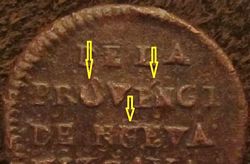 Two coins (types 3 and 5 below) have an inverted number 1. With type 6 the arrows point to very unique features in these coins: the “O” in “PROVINCIA” appears to be open on top; “PROVINCIA” appears to have a tilde and appears as “PROVÍNCIA” instead of “PROVINCIA”; and lastly, the “U” on “NUEVA” is double struck.
Two coins (types 3 and 5 below) have an inverted number 1. With type 6 the arrows point to very unique features in these coins: the “O” in “PROVINCIA” appears to be open on top; “PROVINCIA” appears to have a tilde and appears as “PROVÍNCIA” instead of “PROVINCIA”; and lastly, the “U” on “NUEVA” is double struck.
Type is missing “DE LA” and we consider that given the quality of the rest of the legend, it is unlikely that the missing letters are due to wear, soft strike, but possibly were not included in the die. Between types , “PROVINCIA” is clearly different. Due to wearing on the coins is difficult to make clear comments about the other coins. However, the sizes of the letters in all other coins suggest that they were struck from different dies.
We tried matching these coins with the ones in the collection at the Banco de México (https://www.banxico.org.mx/ColeccionNumismatica). The task was difficult given that, as always, these coins are heavily circulated and the details are elusive. However some coins were identifiable and are listed as follows:
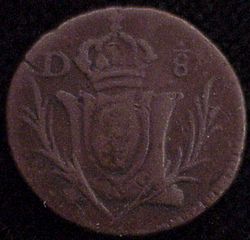
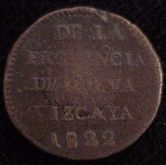
1. Specimen 2818, from 1822. The obverse of this coin is the same as in type 1. Interestingly type 1 corresponds to an 1821 specimen. The reverse is not identifiable.
2. Specimen 2829, from 1822. Matches type 2 meaning these two coins were minted using the same dies.
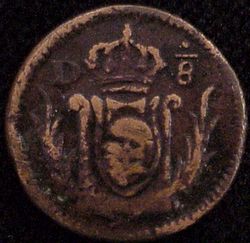
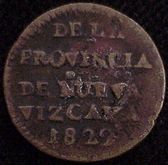
3. Specimen 2821, from 1822. Matches type 3 meaning these two coins were minted using the same dies.
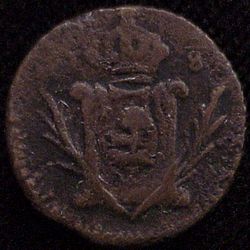
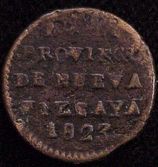
4. Specimen 2826, from 1823. Matches type 7 meaning these two coins were minted using the same dies.
So it can be seen:

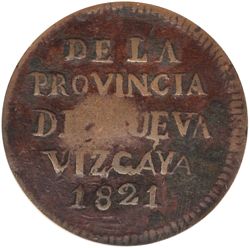
Type 1: Thin, straight wreath. Only variety found from 1821. The die used for the obverse of this coin was used on both 1821 and 1822 coins.
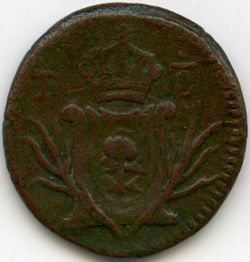
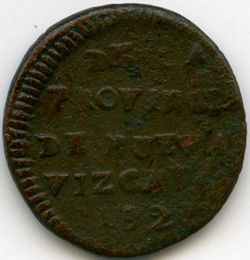
Type 2: Thin, straight wreath. Legend worn.
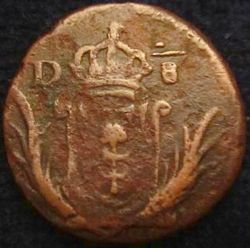
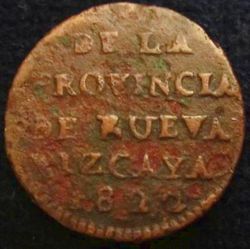
Type 3 : Thick, curved wreath. Deformed “N” in “NUEVA”. Inverted number 1.
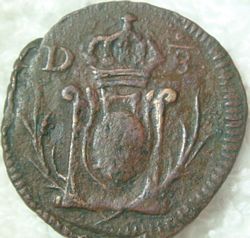

Type 4: Thin, curved wreath. Tall number 2.
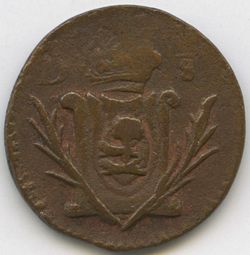
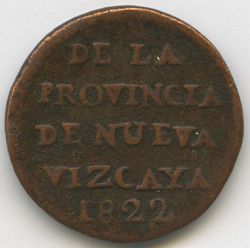
Type 5: Thick, curved wreath. The letters “N“ and “U” in “NUEVA” are united. Inverted number 1.
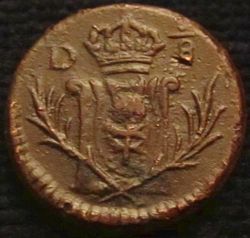
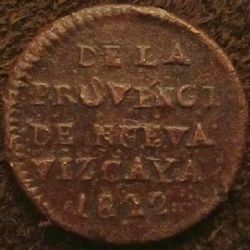
Type 6: Thin, straight wreath, broken crown. Open “O”, tilde in “PROVÍNCIA”, double “U”.
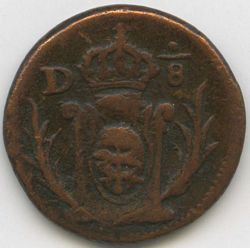
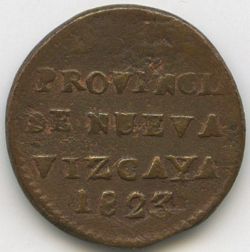
Type 7: Thick, straight wreath. Missing “DE LA”.
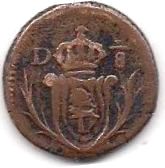
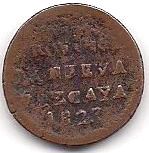
Type 8: Thick, curved wreath. Legend worn.
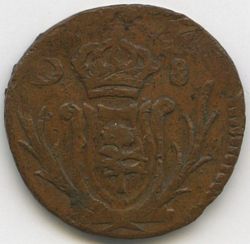
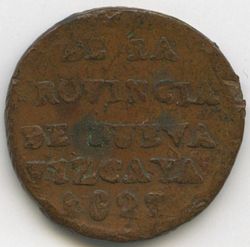
Type 9: Thick, straight wreath. Very crude legend.
Conclusion
These 1/8 real coins saw heavy circulation and therefore are extremely difficult to find in high grade to appreciate their details. However, it is clear that different varieties were struck. Given the large number of types shown, it is plausible the hypothesis that contemporary counterfeits exist, yet the authors were unable to find documentation about this issue or any other authors supporting this theory. However the reader has to remember that some of the 1/8 real coins minted in Durango starting in 1824 (KM#320) are believed to be contemporary counterfeitsHubbard and O’Harrow, op. cit.. Given the propensity of this mint to have multiple varieties of the same year for a given denomination (i.e. Hooknecks, KM#181, etc), it is also possible that all the issues are legitimate and many dies were used to strike these coins. While the authors are only presenting the few varieties that we were able to identify, it is likely that others not described in this paper in fact do exist and collectors are encouraged to look for them.
